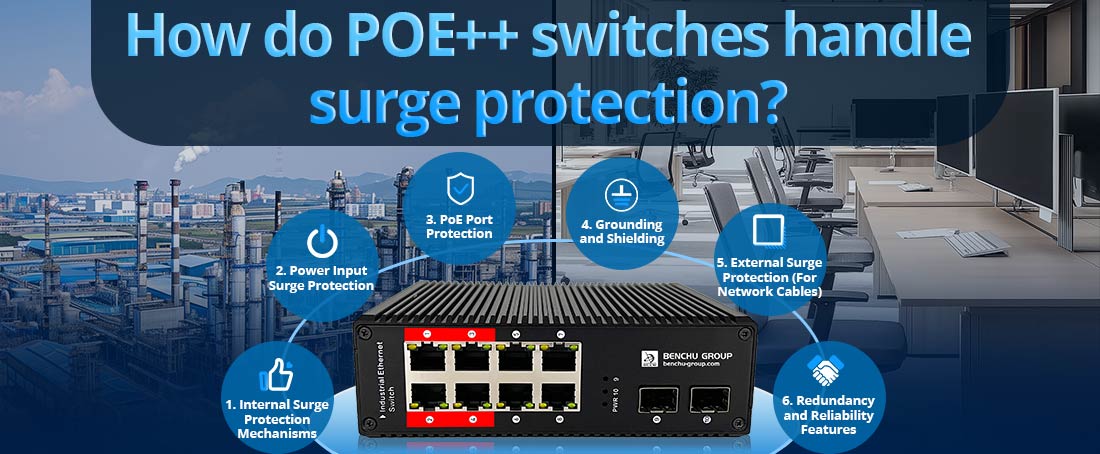
Les commutateurs Power over Ethernet (PoE++), conformes aux normes IEEE 802.3bt, assurent à la fois la transmission de données et l'alimentation via des câbles Ethernet aux appareils connectés. Ces commutateurs doivent également prendre en compte une protection contre les surtensions pour protéger à la fois le commutateur et les appareils connectés contre les surtensions électriques, telles que celles causées par la foudre, les fluctuations du réseau électrique ou les décharges électrostatiques (ESD). Voici comment les commutateurs PoE++ gèrent la protection contre les surtensions :
1. Mécanismes internes de protection contre les surtensions
Diodes TVS (suppression de tension transitoire) : Beaucoup Commutateurs PoE++ sont équipés de diodes de suppression de tension transitoire, qui protègent les composants sensibles des pointes de tension. Les diodes TVS réagissent aux transitoires de haute tension en fixant la tension à un niveau sûr, empêchant ainsi les composants d'être endommagés.
Parafoudres : Certains commutateurs PoE++ sont dotés de parasurtenseurs intégrés, qui absorbent et redirigent l'excès de tension provoqué par une surtension. Ces composants aident à prévenir les dommages aux circuits internes en dirigeant la surtension vers la terre.
2. Protection contre les surtensions d'entrée de puissance
--- La protection contre les surtensions au niveau de l'entrée d'alimentation du commutateur aide à empêcher les surtensions de pénétrer dans le système via l'alimentation CA. Ceci est généralement réalisé grâce à des composants tels que des varistances à oxyde métallique (MOV) ou des tubes à décharge gazeuse (GDT), qui agissent comme des mécanismes de sécurité qui absorbent l'excès de tension avant qu'il n'atteigne l'électronique interne sensible.
3. Protection des ports PoE
--- Pour les ports Ethernet qui fournissent PoE++ (fournissant jusqu'à 60 W par port), la protection contre les surtensions est particulièrement cruciale puisque le même câble transporte à la fois les données et l'alimentation. Les composants de protection contre les surtensions sur chaque port PoE (par exemple, diodes TVS, suppresseurs ESD ou billes de ferrite) aident à prévenir les dommages causés par les surtensions ou les interférences électriques pouvant survenir sur les lignes électriques.
Protection des lignes de données : En plus des lignes électriques, les lignes de données (voies de signal Ethernet) sont également protégées contre les surtensions à l'aide de suppresseurs ESD, qui protègent l'intégrité de la transmission des données et évitent des dommages permanents aux interfaces réseau du commutateur.
4. Mise à la terre et blindage
--- Une mise à la terre appropriée de l'interrupteur est essentielle pour une protection efficace contre les surtensions. En mettant l'interrupteur à la terre, les surtensions électriques sont dirigées loin des composants internes sensibles.
--- Le blindage à l'intérieur du boîtier de l'interrupteur fournit également une couche de protection supplémentaire contre les interférences électromagnétiques (EMI) ou les interférences RF, qui peuvent être une source de surtensions.
5. Protection contre les surtensions externes (pour les câbles réseau)
--- Bien que les commutateurs PoE++ incluent une protection interne contre les surtensions, des dispositifs externes de protection contre les surtensions peuvent être ajoutés au point d'entrée du réseau (c'est-à-dire là où le câble Ethernet entre dans le bâtiment ou l'infrastructure réseau). Ces appareils sont souvent utilisés dans des environnements sujets aux coups de foudre ou aux surtensions externes et offrent une couche de sécurité supplémentaire en atténuant les dommages causés par les surtensions transitant par les câbles Ethernet.
Protecteurs de surtension en ligne : Ceux-ci sont installés entre le commutateur réseau et les appareils connectés. Ils interceptent la surtension avant qu'elle n'atteigne le commutateur PoE++, réduisant ainsi davantage le risque de dommages électriques.
6. Fonctionnalités de redondance et de fiabilité
--- Certains commutateurs PoE++ avancés peuvent offrir des entrées d'alimentation redondantes, garantissant que si une source d'alimentation est compromise en raison d'une surtension, l'autre peut continuer à fonctionner sans interruption.
--- De plus, les commutateurs PoE++ de haute qualité conçus pour les applications industrielles ou critiques sont souvent soumis à des tests rigoureux pour garantir qu'ils peuvent résister aux fluctuations et aux surtensions de tension, améliorant ainsi leur durabilité et leur fiabilité dans des environnements difficiles.
Conclusion
Commutateurs PoE++ utilisez une combinaison de composants de protection contre les surtensions internes, de stratégies de mise à la terre, de blindage et de protection contre les surtensions externes pour garantir la sécurité et la longévité du commutateur et des appareils connectés. Les éléments clés incluent l'utilisation de diodes de suppression de tension transitoire, de parasurtenseurs, d'une mise à la terre appropriée et de dispositifs de protection externes en option, qui fonctionnent tous ensemble pour gérer efficacement les surtensions électriques et éviter d'endommager le système.